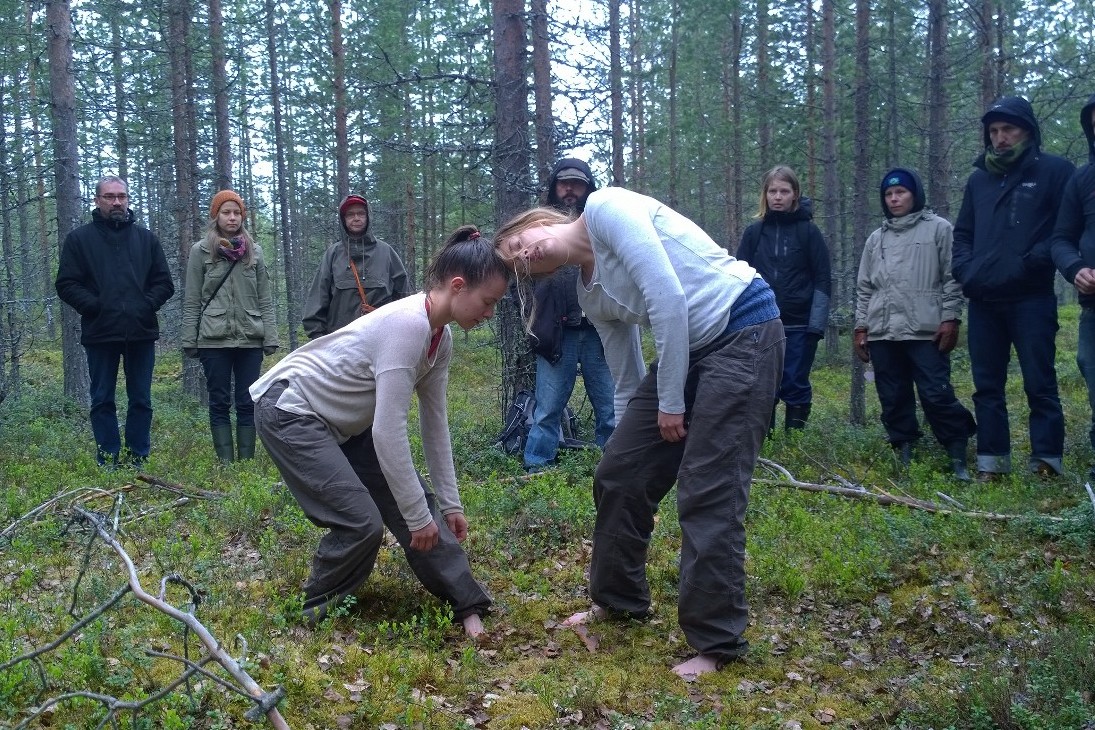
Sade Kamppila and Viivi Roiha perform in ‘The Forest Project’, a circus-dance-theatre-music piece
Venues around Kaukonen, Lapland
The village of Kaukonen sits 130km north of Rovaniemi, the city where chartered aircraft dump families visiting Santa Claus in the run-up to Christmas. Kaukonen is deep inside Lapland and it’s tiny. Administrators at the Silence Festival warn you before arrival that there’s no shop in the village and no cash dispenser. They have no need for such things here. They don’t have much need for visiting journalists either: I have to sneak in under the guise of a volunteer.
But that’s fine. Everyone is here to help, to share, to collaborate and to do things they’ve not done before. At the heart of the Silence Festival’s programme are odd encounters. Many artists here are rooted in the Nordic circus tradition. They do their charming, enchanting, contorting thing but are constantly shunted up against musicians, filmmakers, actors, poets, dancers, cartoonists and performers of no fixed definition.
Lots happened under Lapland’s continuous summer sun from Wednesday to Saturday. There was a thigh-slapping covers set from the village rock band in the sitting room of a private cottage; there was a performance of the suite from Stravinsky’s A Soldier’s Tale amid the clean lines of a public art gallery in a forest some miles away.
But I’ll leave with one show etched more deeply in my memory than any other. The Forest Project is a circus-dance-theatre-music piece that, in this particular incarnation, saw an audience of around 50 led through an ancient forest by Sade Kamppila and Viivi Roiha. The shamanistic, emotionally humid performance ends with both performers naked, hurling themselves at the forest’s peat and bracken after all manner of physical ordeals, kooky jokes and striking bodily contortions that illuminate an ancient Finnish philosophy. As we trudged back through the trees to the awaiting bus, the two women appeared once more: sat on a rocky outcrop in the distance, on the other side of a lake, singing and signalling to us over the small fire they’d built to dry themselves, far away enough to seem almost like an illusion.
The performers seemed like lovers slowly torn apart.
Now and then Silence Festival broke out of Kaukonen’s confines, mostly to the nearby town of Kittilä. In Kittilä’s small church bandoneón player Henrik Sandås played music from 20th-century Argentina, while poet Juha Rautio recited his own verse. You don’t need to understand a word of Finnish to be moved by the inbuilt northern music of Rautio’s words, nor the resonance of bittersweet Argentinean tango delivered in a country that has since made the form its own. At the end of Piazzolla’s La Familia, Sandås’s bandoneón appeared to unfurl the transfiguring cadence that ends Sibelius’s Tapiola. That might be how Piazzolla’s piece is written; it might not – I don’t care. I felt it as closely as the bandoneón’s breath.
In the opposite direction from Kaukonen is a woodland idyll commemorating the work and life of painter Reidar Särestöniemi. It was a busy 90 minutes here, starting with Outi Tarkiainen’s wind-blown Kunnes kivi halkeaa, dug purposefully into by violinist Minna Pensola, while Elice Abonce Muhonen was yanked up to the ceiling by her hair. In total, invigorating contrast, Alex Newton and Anthony Curt’s choreography for A Space In Between was urbane and poetic, danced by Emma Lister and Oliver Speers to music by Einojuhani Rautavaara, Toivo Kuula and an improvisation from the performing musicians Pensola and pianist Anna Laakso. Lister and Speers seemed like lovers slowly torn apart, set off by the raw power of the musicians.
That was as lofty as Silence Festival got. Back at Kaukonen, events remained purposefully as ram-shackled and rooted as the village itself. But there was always a clear creative point to what happened. At Villa Magia, the little hut that is Kaukonen’s spiritual home, cartoonist Ville Ranta live-sketched to the improvised accompaniment of guitarist Aleksi Ranta (his brother) and accordionist Niko Kumpuvaara (their childhood friend). Up the hill at the community centre, there were film screenings, a burlesque strip show, scented acrobatics from Ana Jordão, traditional Argentinean songs from Juan Manuel Vazquez and another, final set from the crooning village band.
Joining them on stage in Silence Festival’s dying minutes was the altitudinous guitarist Marzi Nyman. Everywhere you turned during these four days, it seemed Nyman was there, waiting for you, towering in his bright red pinstriped suit and brandishing his electric guitar, always able to yank whatever discourse he found himself embroiled in up to another level.
Nyman had played the festival’s first notes: a series of brief, surging loops like three concurrent wind speeds. He was there too, on Saturday morning, standing on the banks of the wide, fierce River Ounasjoki as Sanja Kosonen crossed it on a tightrope. To a circus newbie like me, her feat felt miraculous, but I’m sure that had something to do with the presence of Nyman in his red suit, and the strange, cosmic sounds of his guitar. ![]()